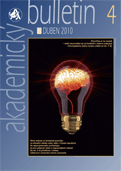Physics helps economy: a new monograph on Econophysics from the Institute of Physics, AS CR

12 Mar 2014
Importance and impact of methods and techniques developed for studying physical problems has outreached the realm of natural sciences. Methods of quantum physics and statistical mechanics find more and more applications in biology, economy, informatics, or sociology. Physics has become one of the most important components of a number of new interdisciplinary research fields. Econophysics utilises methods of statistical mechanics and theory of phase transitions to model and understand processes in economy and financial markets.
Brain Awareness Week

10 Mar 2014
Every March, the European Dana Alliance for the Brain (EDAB) coordinates Brain Awareness Week, when hundreds of public events in dozens of countries celebrate progress in brain research and inform the general public about their overall results. In the Czech Republic, Brain Awareness Week activities are organized by the Institute of Experimental Medicine ASCR and by Czech Society of Neuroscience, by the Centre of Neuroscience and by the Centre of Administration and Operations ASCR.
Relativity shakes a magnet

4 Mar 2014
Researchers from Institute of Physics AS CR demonstrate a new principle for magnetic recording
Current technologies for writing, storing, and reading information are either charge-based or spin-based. Semiconductor flash or random access memories are prime examples among the large variety of charge-based devices. They utilize the possibility offered by semiconductors to easily electrically manipulate and detect their electronic charge states representing the “zeros” and “ones”. The downside is that weak perturbations such as impurities, temperature change, or radiation can lead to uncontrolled charge redistributions and, as a consequence, to data loss.
Magnetic inside but not on outside

3 Feb 2014
A new theory explaining the origin of hydrocarbon molecules in interstellar space

22 Jan 2014
New Nikon Centre of Excellence in Super Resolution Microscopy at the Institute of Molecular Genetics of the Academy of Sciences, Czech Republic

22 Jan 2014
20 Years of the Academy of Sciences of the Czech Republic

4 Dec 2013
On the occasion of the 20th anniversary of the creation of the Academy of Sciences of the Czech Republic, there was a press conference in the Prague headquarters of the most important Czech scientific institution. The history of the Academy of Sciences of the CR with an emphasis its essential role in society, breakthrough moments and main developmental stages was first raised by its current president, Prof. Jiří Drahoš. It was then commemorated by his three predecessors in the leading post of the ASCR – Prof. Rudolf Zahradník, Prof. Helena Illnerová and Prof. Václav Pačes.
Epigenetic diversity increases the productivity and stability of plant populations

28 Nov 2013
Humanity is dependent on natural ecosystems as sources of food, but they also provide other essential services. The preservation of biological diversity is a fundamental challenge for contemporary environmental protection. Recent research has found that intraspecific diversity plays an equally vital role in the functioning and stability of ecosystems as interspecies diversity. Intraspecific diversity was until now always attributed to phenotypic and functional diversity of individuals, secured thanks to the variability of DNA. Nevertheless, the phenotype is controlled only by the base sequence of nucleotides in the DNA, but is also controlled by epigenetic variation.
Why does the cuckoo win the battle with its host?

25 Nov 2013
Czech Astronomers are the first to have captured the optical afterglow of a gamma burst

20 Nov 2013
On 30 October at 10 PM, a so-called gamma burst flared in the constellation Aquarius. It was recorded in space by the satellite Swift. Astronomers from the Group of Astrophysics of High Energies Group of the Stellar Section of the Astronomical Institute of the ASCR started monitoring it only 41 seconds after the placements of the optic telescope at the observatory in Ondřejov and were so the first in the world. They are gigantic energetic flashes in the area of gamma radiation, which energy comparable with the emission of the Sun for its entire lifespan is released over a few seconds or tens of seconds. The distance of the object in space was calculated as 9 billion light years.






